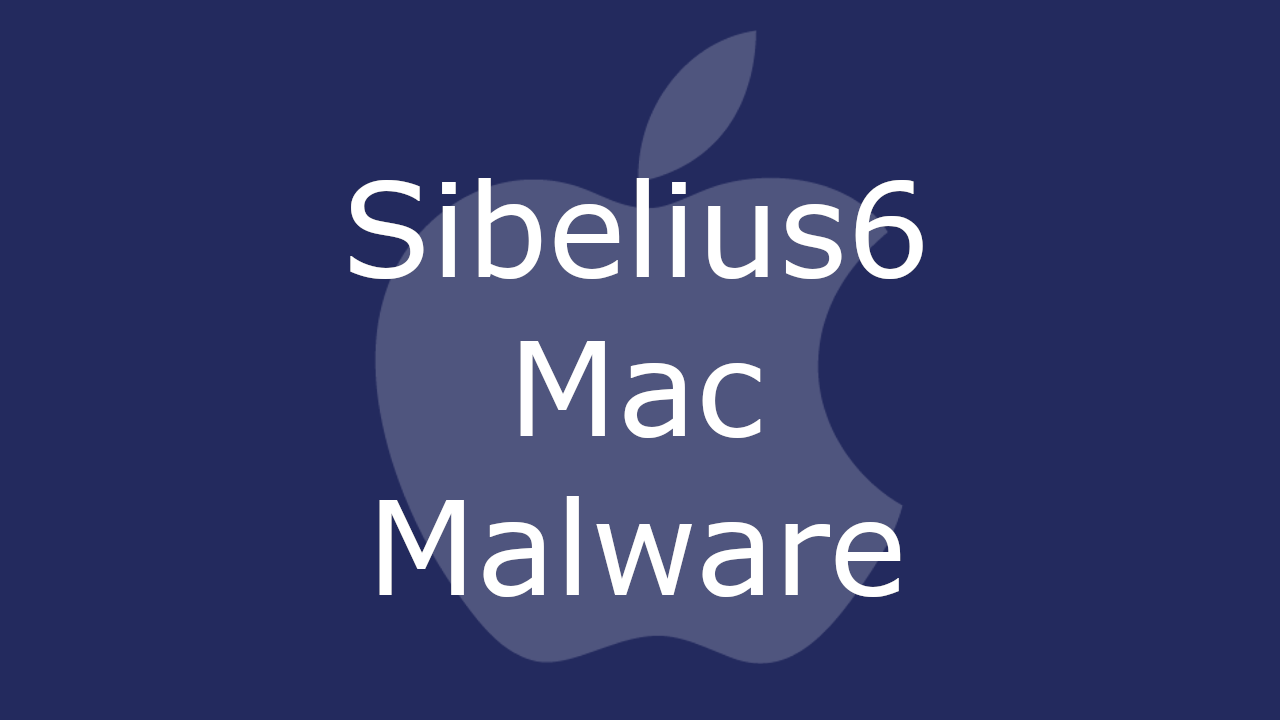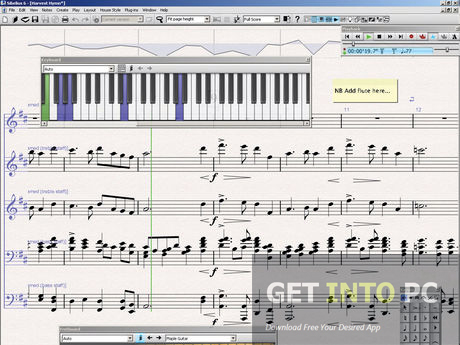Sibelius 6 Download Mac
Sibelius 6 download free mac. Education downloads - Sibelius 6 Student by Sibelius and many more programs are available for instant and free download.
The Library directories are where the system and your code store all of their related data and resources. In macOS, this directory can contain many different subdirectories, most of which are created automatically by the system. In iOS, the app installer creates only a few subdirectories in ~/Library (such as Caches and Preferences) and your app is responsible for creating all others.
Download free music notation software. With Sibelius First you can start composing music using the same tools professional composers use. Get it now for free! 2002: Sibelius is first major music program for Mac OS X. Company acquires music software company MIDIworks. 2003: Revenues beat competitor MakeMusic Inc. By 20%, confirming Sibelius as world market leader. Starclass, Instruments, G7 and G7music.net launched. Sibelius Group commences distributing Musition and Auralia. Sibelius in Japanese.
Table A-1 lists some of the common subdirectories you might find in a Library directory in macOS along with the types of files that belong there. You should always use these directories for their intended purposes. For information about the directories your app should be using the most, see The Library Directory Stores App-Specific Files.
Subdirectory | Directory contents |
|---|---|
| Contains all app-specific data and support files. These are the files that your app creates and manages on behalf of the user and can include files that contain user data. By convention, all of these items should be put in a subdirectory whose name matches the bundle identifier of the app. For example, if your app is named MyApp and has the bundle identifier Resources required by the app to run must be placed inside the app bundle itself. |
| Contains programs that assist users in configuration or other tasks. |
| Contains audio plug-ins, loops, and device drivers. |
| Contains app-specific autosave data. |
| Contains cached data that can be regenerated as needed. Apps should never rely on the existence of cache files. Cache files should be placed in a directory whose name matches the bundle identifier of the app. By convention, apps should store cache files in a subdirectory whose name matches the bundle identifier of the app. For example, if your app is named MyApp and has the bundle identifier |
| Contains resources for picking colors according to a certain model, such as the HLS (Hue Angle, Saturation, Lightness) picker or RGB picker. |
| Contains ColorSync profiles and scripts. |
| Contains system bundles and extensions. |
| Contains the home directories for any sandboxed apps. (Available in the user domain only.) |
| Contains plug-ins for extending system-level contextual menus. |
| Contains data files with web browser cookies. |
| Contains data used by Xcode and other developer tools. |
| Contains language dictionaries for the spell checker. |
| Contains documentation files and Apple Help packages intended for the users and administrators of the computer. (Apple Help packages are located in the |
| Contains device drivers and other kernel extensions. |
| Contains aliases to frequently accessed folders, files, or websites. (Available in the user domain only.) |
| Contains font files for both display and printing. |
| Contains frameworks and shared libraries. The |
| Contains plug-ins, libraries, and filters for web-browser content. |
| Contains keyboard definitions. |
| Specifies the agent apps to launch and run for the current user. |
| Specifies the daemons to launch and run as root on the system. |
| Contains log files for the console and specific system services. Users can also view these logs using the Console app. |
| Contains the user’s mailboxes. (Available in the user domain only.) |
| Contains plug-ins for the System Preferences app. Developers should install their custom preference panes in the local domain. |
| Contains the user’s preferences. You should never create files in this directory yourself. To get or set preference values, you should always use the |
| In the system and local domains, this directory contains print drivers, PPD plug-ins, and libraries needed to configure printers. In the user domain, this directory contains the user’s available printer configurations. |
| Contains QuickLook plug-ins. If your app defines a QuickLook plug-in for viewing custom document types, install it in this directory (user or local domains only). |
| /fitbit-mac-app-store/. Contains QuickTime components and extensions. |
| Contains screen saver definitions. See Screen Saver Framework Reference for a description of the interfaces used to create screen saver plug-ins. |
| Contains scripts and scripting resources that extend the capabilities of AppleScript. |
| Contains system alert sounds. |
| (Deprecated) Contains system and third-party scripts and programs to be run at boot time. (See Daemons and Services Programming Guide for more information about starting up processes at boot time.) |
| Contains web server content. This directory contains the CGI scripts and webpages to be served. (Available in the local domain only.) |

Copyright © 2018 Apple Inc. All Rights Reserved. Terms of Use Privacy Policy Updated: 2018-04-09
Aug 27, 2015 Sibelius, free and safe download. Sibelius latest version: Advanced and Efficient Music Creation Software for Professionals. When it comes to creating.
If you deploy Sibelius in your environment, you may or may not have a Sibelius Licence Server to manage the checking in and out of your licenses. From personal experience, it’s immensely helpful in terms of license management – only having licenses in use when machines are actively running the software-, managing license upgrades, as well as managing deployments. While not every environment is the same, if you happen to have standalone Sibelius licenses instead of a multi-seat network license, I would highly recommend it.
This post covers the process of setting up a Sibelius License Server and deploying Sibelius to your Macs. I obviously don’t know your network, so there may be some “gotchas” on that side of things that will require working with your Network Admin to get this working.
Sibelius Download Mac. Sibelius 8 Free Download gives you to create the musical notes with ease. This software is widely used by the arranger, DJ and students. It can be edit and plays the song before printing. It recognizes the user to generate a musical note without typing but with how to play the piano and guitar received in the program. Sibelius 6 free full. Download For Mac Os; 8/10 (24 votes) - Download Sibelius Mac Free. Download Sibelius for Mac right now, an advanced musical notation tool. With Sibelius you can compose and edit scores in a flexible and efficient manner. Sibelius is a program for musicians, composers and music arrangers. With this application you'll. Sibelius 6 download free mac. Education downloads - Sibelius 6 Student by Sibelius and many more programs are available for instant and free download. Sibelius 7 Download; The Library directories are where the system and your code store all of their related data and resources. In macOS, this directory can contain many different subdirectories. Dec 04, 2015 Hi all, hope you are well! Just trying these for the first time in Logic X, Mac running Catalina but the vst doesn’t work:( So I grabbed the manual samples (unless someone knows how to get the vst to work!) Anyhoo, manual samples. I have 5 Roland pads I’m triggering but there’s a bunch of roto tuned notes.
The component of this deployment that I found recently some folks were missing (and we missed initially as well) was the local LicenceServerInfo file. This is what tells Sibelius where to communicate in order to check out licenses, and for whatever reason isn’t well documented.
See more below the jump.
LicenCe vs. LicenSe: a Disclaimer
If you live in the US, this disclaimer is for you!
When we’re talking about the word license as a noun, the spelling is different in the US than the rest of the world. It’s because we like being different?
If you do a quick search online, you’ll find articles like this one that show in the US it’s a license with an “s”, while elsewhere it’s spelled licence with a “c”.
While you might be thinking “potatoe potatoe”, the spelling actually matters in the case of Sibelius when configuring your Macs as the local file that points to your license server does spell it with a “c”. Since I am from the US, I will use the license spelling wherever I can … except when it matters.
You’ve been disclaimed!
Multi-Seat Network License
In order to take advantage of the Sibelius Licence Server, you need to get yourself a multi-seat network license. You can get this license with as many seats as you need. Being in the New York area, our nearest and long-time stellar Audio/Video company and Avid license vendor has been Sweetwater. So if you’re thinking about making a purchase and you happen to be in NY, definitely reach out to them.
You can see more details about the license and how it works here.
For a detailed Sibelius Licence Server install & upgrade guide, see this Avid KB article for the complete Sibelius Licence Server Guide.
Install Sibelius Licence Server
You’ll need to login to your Avid account and download the installer. We’ve opted to run our various license servers on a single Mac mini, but whatever makes sense for you and your environment. You’ll also need your System ID – listed next to your Sibelius entry under your Avid products – and your Activation ID – listed within the list of Sibelius downloads.
Just a quick note: starting in 2018, Avid updated its versioning from its older scheme (ex. 8.4.2) to a new one which indicates the year and month of the software release. More details here. This new versioning hasn’t yet made its way to the Sibelius Licence Server (the latest version as of this writing is 8.4.2), so don’t worry about this discrepancy when you see it.
Run the PKG installer.
Configure Sibelius Licence Server with Your License
If you’re on a Mac, the Avid Application Manager icon will be available in the menu bar. Authenticate with your Avid account credentials.
Depending on your network, you may or may not be able to authenticate your multi-seat network license over the Internet. The good news is there’s an offline activation option, so if you’re like us this may be your best (or only) option. A link will be available in the app to the applicable webpage if you need to go this route.
Enter your System ID, Activation ID, and for offline activation also the activation file you produce. Once successfully activated, open your Sibelius License Control Panel and verify you see the number available seats listed.
Prepare Your Sibelius Deployment
If you haven’t already, make sure you have the latest Sibelius installer downloaded. Extract the PKG from the DMG and load / import it wherever your environment’s software installations (munki_repo, Jamf Distribution Point, etc.).
A couple of important points about the Sibelius installer …
The installer itself contains several items that won’t get installed by default when deployed remotely. One many being the various Sibelius scores in different languages. As such, if you happen to be using munki to deploy Sibelius, you have a couple of things to do after importing into your repo:

1) Add an installer_choices_xml array to your pkginfo file for each of the package IDs contained in the Sibelius installer. In our environment we only install the application, fonts, rewire, and applicable scores.
We notably exclude the Avid Application Manager (com.avid.tmp.AppMan.pkg) from our installation because our users won’t ever sign in or update the software. A year or two ago we also isolated an issue where while the Avid App Manager was running any wireless AirPlay streams from the Mac would be incredibly poor and choppy.
If you do want to install the manager, you can opt to simply remove the app manager LaunchAgent (/Library/LaunchAgents/com.avid.ApplicationManager.plist) so it won’t launch automatically when a user logs in. You can do this in munki, Jamf, and other tools via a postinstall script.
2) Make any package IDs in your receipts array that you don’t install optional. Otherwise, when munki does its automated run it will continually reinstall the software. Even if you don’t opt to go the installer_choices_xml array route, you will still have to mark a number of these package receipts as optional.
Sibelius Licence Server File

The last piece to your deployment will be the Licence Server file (spelling matters here). Sibelius looks for this on launch, and if found will attempt to communicate and check out a license.
Sibelius 6 Download Mac Os
The full path to the file is below:
/Library/Application Support/Avid/Sibelius/_manuscript/LicenceServerInfo
The file itself is nothing special. It should contain a single line with the IP address or hostname of your Sibelius Licence Server. It should have an owner and group of root:admin with 755 permissions, just like all of its parent folders.
You can choose to either script the creation of the file, it’s contents, and parent folders, or just make an installer with the file and folders. We opt for the latter.
Test Deployment
Once you have everything setup, test your deployment. If all is configured correctly, launching Sibelius for the first time will indicate it’s using a network license with small text at the bottom left corner of the launch window.
Future Sibelius Deployments

As mentioned in the beginning, the great thing about using Avid’s multi-seat network license is that it makes upgrading the software and your license much easier.
So long as your license is up-to-date, you can remotely push Sibelius PKG installers to your deployed Macs and they will still refer to your Sibelius Licence Server for checking out licenses.
Sibelius 7 Download

Sibelius 6 Download Mac Latest
And whenever you purchase your annual license support renewal, you can deactivate your current license in the Avid Application Manager on your server and add the new one. Any of your already deployed Macs, regardless of the version they’re on, will continue to check out licenses from the server.
Description of Avid Sibelius Ultimate 2020.6
Sibelius Mac Crack
Avid Sibelius Ultimate 2020.6 is the world’s best-selling music notation software, offering sophisticated, yet easy-to-use tools that are proven and trusted by composers, arrangers, publishers, educators, and students alike. And with the new Sibelius, you can access the software in more affordable ways than ever.
Compose, arrange, and engrave without limits
Sibelius | Ultimate (formerly Sibelius—learn more) offers an advanced toolset, enabling you to work with an unlimited number of instrument parts and tailor every facet of your score to your needs. Create sophisticated sheet music with an expanded set of notation tools and symbols, customizable notes and instruments, and film scoring workflows. And speed through score refinement with advanced layout, editing, and publishing tools.
Polish your score to perfection
With a full suite of desktop publishing tools and score Inspector, you can control and finesse every score element with ease. Fine-tune lyrics, dynamics, and other text with tracking, leading, scaling, and alignment tools. Use hierarchical styles to change fonts and add emphasis. Add graphics using drag-and-drop. Even create your own house styles and manuscript papers to give your scores a unique look and feel.
Write music quickly and easily
Sibelius | Ultimate features a task-based interface that leads you through the entire score creation process. Enter notes from the onscreen notation, keyboard, or fretboard windows, or from your MIDI keyboard. Add notational elements, dynamics, custom symbols, and text. And easily navigate large, complex scores using the timeline.
Share your work
Easily share an unlimited number of scores online using Sibelius | Cloud Sharing and invite others to view, play, and comment on your music. Expand your storage space with an Avid Cloud Premium Plan. You can also collaborate through MusicXML, print scores, and export your music as MP3, MIDI, or PDF files.
Create beautiful scores fast
Spend more time writing music instead of fixing it. As you write, Magnetic Layout automatically gives everything just the right amount of space and avoids collisions to produce beautiful results, cutting writing time in half. And Dynamic Parts can automatically create and update separate instrumental parts whenever you change your score.
Add comments directly on a score
With the Annotate feature, you can draw freeform directly on a score and communicate edits, instruction, and feedback to collaborators, arrangers, musicians, or students—streamlining collaboration and review. All annotations are grouped intelligently and always remain attached to the bar to which you’ve added them. Plus, they can be switched off, so they don’t appear when printing.
Turn music into scores
Sibelius comes with two companion applications that enable you to turn recorded, performed, printed, and handwritten music into notation. With AudioScore Lite, you can input notes by singing or playing a monophonic instrument through a microphone. With PhotoScore & NotateMe Lite, you can turn printed, PDF, and JPEG sheet music into editable scores—and even handwrite music.
Practice and perform with your iPad
Got an iPad? Export your score for Avid Scorch, an iOS app that transforms your iPad into an interactive music stand and score library for practice and performance. With Avid Scorch on your iPad, you can view scores and adapt them to your instrument by transposing the music, changing instruments, or even converting to and from guitar tab.
and more…
Homepage https://www.avid.com/sibelius
Sibelius 6 Free Download Mac
Screenshots of Avid Sibelius Ultimate 2020.6
Sibelius Mac Download Crack
| Name: | Avid.Sibelius.Ultimate.v2020.6.macOS_123mactorrent.com.zip.torrent |
|---|---|
| Size: | 881 MB |
| Files | Avid.Sibelius.Ultimate.v2020.6.macOS_123mactorrent.com.zip.torrent |